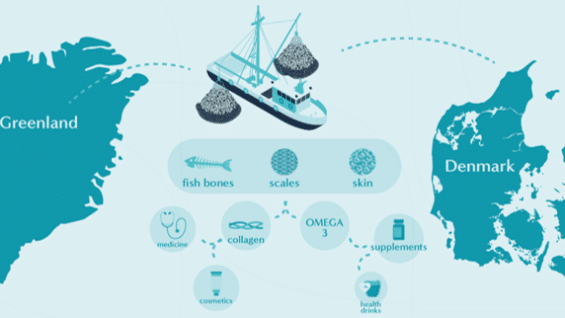The BlueRev Case Studies – Best Practices from Estonia
Estonia: Algae-Based Business Models
Context and Challenges
In Estonia, the focus was on leveraging algae resources, particularly red algae (Furcellaria lumbricalis), to develop sustainable business models for applications in cosmetics, nutraceuticals, bioplastics, and other value-added products. Co-creation workshops engaged academic researchers, SMEs, and environmental organizations, emphasizing empathy-driven ideation to address challenges such as the Baltic Sea’s low salinity and lengthy permit processes for algae cultivation, and technical solutions for growing different macroalgae species and exploring the product development options. One notable innovation opportunity involved integrating macroalgae cultivation with offshore wind farms to maximize marine spatial efficiency and support nutrient management. Additional innovation opportunities lie in the exploration of integrated multitrophic aquaculture with the cultivation of green algae Ulva intestinalis and mussels in fish farms.

Best Practice Identified
Specific case: Nutraceuticals and cosmetic applications of red algae.
Since the 1960s, red algae from the shallows near Saaremaa has been used to produce furcellaran, a gelling agent widely utilized in the food industry. Harvesting this resource involves both trawling and beach collection, with current environmental permits allowing up to 2,000 tons of red algae trawling annually, although actual trawling volumes have yet to reach this limit. In addition to furcellaran, red algae are a potential source of microcellulose, highlighting an opportunity to repurpose processing by-products. Furcellaran production has traditionally focused on the food industry, but transforming furcellaran into powder opens new applications within cosmetics. This development is being explored to create a high-value ingredient, expanding beyond the conventional production of flaky furcellaran.
The challenges are:
- Technical Operational and Logistical challenges and ecological limitations in scaling macroalgae production in the Baltic Sea.
- The need for Regulatory and Governance Frameworks to incentivize sustainable practices and foster collaboration among stakeholders.
- Market Acceptance and Consumer Perception due to limited examples of nutrient trading, limited awareness and access to global intermediaries.
- Access to Investments is limited, as local financial institutions have very limited understanding of the specific sector and regard this field as a very high-risk activity.
Social and Environmental Impact
The macroalgae industry can balance ecological preservation with social and economic benefits implementing the transformation of algae into high value products for nutraceuticals and cosmetics. By addressing the challenges of scaling production, integrating sustainable practices, and fostering collaboration among stakeholders’ possible impacts could be:
Environmental:
- Waste Reduction Through Full Resource Utilization: The processing creates multiple valuable products (furcellaran, microcellulose). This circular economy approach maximizes the value of harvested biomass with a Low Environmental Impact Production, since Red algae doesn’t require agricultural land, irrigation or fertilizers. The red seaweed processing residue is utilized as biofertilizer.
- The harvesting and collection of red seaweed contribute to the nutrient removal from the Baltic Sea, which is particularly relevant given the environmental condition of the Baltic Sea.
Social:
- Economic Opportunities: Furcellaran production supports local economies, by creating jobs in harvesting, processing, and product innovation. Expanding applications in cosmetics, food, biofertilizer and bioplastic production could further stimulate economic growth and diversification in coastal communities.
- Community Engagement and Cultural Value: Red algae harvesting has cultural significance in some coastal areas, contributing to local heritage and identity related to collection of beach cast. The cultural significance also lies in the historical uniqueness of furcellaran production and the utilization of very specific local resources. Ensuring sustainable practices respects these traditions while balancing economic growth.
Implementation Guidelines
- Stakeholder Engagement
- Collaborate with local and international researcher to find technical solutions for scaling macroalgae production in the Baltic Sea and product development.
- Organize meetings regulatory and governance body for developing frameworks to incentivize sustainable practices and fair access to resources and ease the regulatory bottle necks.
- Market Development
- Increase awareness in consumers and local communities to foster acceptance and demand, access to markets.
Key To-Dos for Stakeholders
- Industry and Private Sector (Algae harvesters; Macroalgae processors; Biotechnology and innovation companies): Develop and implement sustainable harvesting techniques to minimize ecological impact; Invest in innovation to optimize macroalgae cultivation and processing and explore by-product applications and value chain development.
- Governance and Regulatory Bodies (Local and national governments; Environmental agencies; International regulatory organizations): Monitor compliance to environmental regulations. Support policies promoting nutrient trading and carbon-neutral operations. Assess regulatory processes, timelines and information dissemination to the industry.
- Research and Innovation Community (Universities and research institutions; Product developers in food, cosmetics, and bio-based industries): Tackle technical challenges in scaling macroalgae cultivation and production and collaborate with industry to create innovative solutions for ecological and logistical challenges.
- Educational Institutions (Applied and Higher education institutions): develop and update study programs to support the production of highly skilled labour for the industry. Initiate industrial doctorates and joint programs with industry to build R&D capacity.
- Civil Society and Consumers: Raise awareness about the ecological and socio-economic benefits of sustainable algae-based products to improve consumer demand and support for sustainable harvesting practices.
Scaling and replicability
Collaborations among researchers, small businesses, and environmental organizations aimed to enhance resource efficiency and expand markets for algae-based products, such as cosmetics and nutraceuticals. Algae, particularly macroalgae, rich in bioactive compounds, is used in food, cosmetics, biofuels, and pharmaceuticals. For instance, algal oils can replace petroleum in biofuel production, while alginates from seaweed are applied in food processing and packaging.




